Light Duty Cranes: Light Crane Types & Systems 250kg, 500kg,1000kg
Light duty crane for sale. All types of light crane & crane system, including light duty bridge crane, light gantry crane & light jib crane. Hot sale 250kg, 500kg,1000kg.
Light cranes and their associated systems represent versatile and efficient solutions tailored for handling moderate loads within weight capacities ranging from 250kg to 1000kg. These specialized systems are designed to facilitate material handling tasks in various industrial settings with precision, flexibility, and space-saving features.
Overview of Light Duty Crane & Light Duty Crane Systems
Light cranes encompass a range of crane types, including overhead cranes, gantry cranes, and jib cranes, each engineered to optimize lifting capabilities while occupying minimal space. Their adaptability and mobility make them ideal for workshops, manufacturing units, maintenance areas, and assembly lines where precise load handling and maneuverability in confined spaces are paramount.
Light crane systems consist of crucial components such as hoists, trolleys, support structures, and electrical systems, working cohesively to enable seamless lifting, movement, and positioning of loads. These systems offer diverse configurations, including floor-mounted, wall-mounted, and portable options, catering to specific operational requirements and spatial constraints within industrial facilities.
The overarching aim of light crane systems is to enhance operational efficiency, productivity, and safety by providing reliable and flexible material handling solutions suited for moderate load capacities. Their versatility and space-saving design make them indispensable tools across various industries, streamlining workflows and ensuring efficient handling of goods and materials.
Light duty overhead cranes are specifically designed to handle lighter loads, typically ranging from 250kg to 1000kg. These cranes find extensive use in industries where the demand for lifting objects within this weight range is frequent. From smaller manufacturing units to workshops and assembly lines, these cranes are the workhorses for tasks that demand precision and control.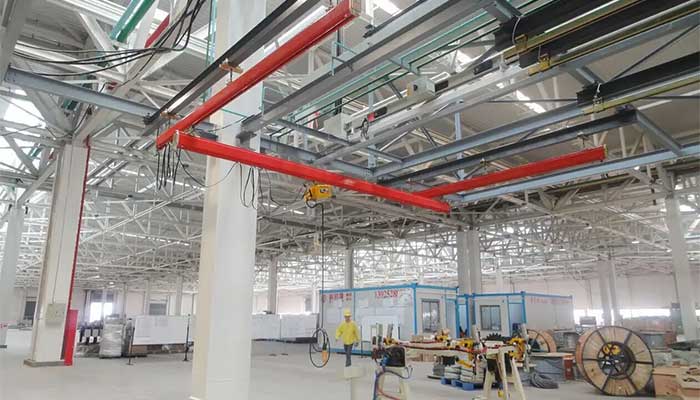
Exploring Configurations, Variants, Advantages, and Limitations
Light duty overhead cranes come in various configurations tailored to suit different operational requirements. They may be single girder or double girder setups, with flexibility in span and height. While their adaptability and ability to cover a wide operational area are definite advantages, they do have limitations in terms of maximum load capacities.
The advantage of these cranes lies in their cost-effectiveness, ease of installation, and maneuverability. However, it's essential to acknowledge their limitations regarding the maximum load they can handle. It's crucial for industries to understand the exact specifications needed for their operations to ensure optimal performance without compromising safety.
These cranes provide efficient solutions for businesses looking to enhance productivity without investing in heavy-duty machinery, catering to operations that demand precision and speed.
As we delve deeper into the world of light duty cranes, the subsequent sections will explore various types and systems designed for these specific weight capacities.
Light Duty Overhead Cranes
Light duty overhead cranes offer versatility not just in their load capacities but also in their installation configurations. Among the various options available, the distinction between ceiling-mounted and floor-mounted setups holds significance based on the spatial requirements and operational needs of different industries.
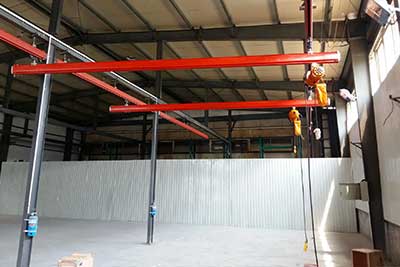
Single Girder Light Workstation Crane
Design and Features:
A single girder light workstation crane consists of a single horizontal beam (girder) that supports the hoist and trolley mechanism. It's specifically designed for lighter lifting tasks within the weight capacity range of 250kg to 1000kg.
This crane is typically mounted on the workshop ceiling or an overhead support structure. Its compact design allows for optimal use of available workspace without obstructing floor operations.
Due to its single girder configuration, this crane offers simplicity in design, ease of installation, and cost-effectiveness while meeting moderate lifting requirements.
Applications:
Single girder light workstation cranes find application in smaller workshops, assembly lines, and manufacturing units where precise and controlled lifting of lighter loads is required.
They are well-suited for handling materials or components in confined spaces where a compact lifting solution is essential for optimizing workflow efficiency.
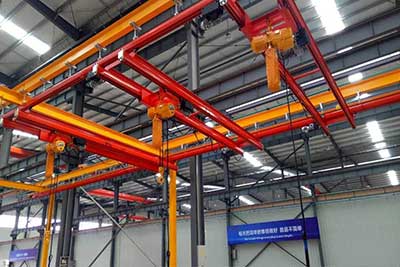
Double Girder Light Workstation Crane
Design and Features:
A double girder light workstation crane comprises two parallel horizontal girders supporting the hoist and trolley system. This configuration allows for increased stability, higher lifting capacities, and wider spans compared to single girder cranes within the light duty range.
These cranes are also mounted on the workshop ceiling or support structure but provide enhanced load-bearing capabilities due to the dual girder design.
Applications:
Double girder light workstation cranes are suitable for slightly heavier lifting tasks within the light duty range, typically ranging from 500kg to 2000kg.
They are commonly used in workshops, production lines, or manufacturing environments where moderate to heavier loads need to be handled efficiently while maintaining stability and precision.
Both configurations, single girder and double girder light workstation cranes, cater to specific lifting requirements within the light duty range. The choice between them depends on the load capacities, span requirements, and precise lifting needs of the workstation or operational environment.
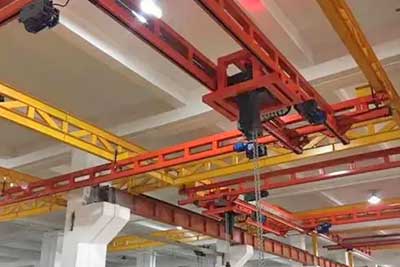
Ceiling Mounted Light Duty Overhead Cranes
Ceiling-mounted cranes are affixed to the ceiling structure of a facility, utilizing the overhead space effectively. They are an ideal choice when floor space is limited or when unobstructed movement across the ground is crucial for other operations. These cranes provide an unimpeded working environment and allow for maximum utilization of the available floor space.
The installation of ceiling-mounted cranes requires sturdy support structures to ensure the safe and efficient operation of the crane system. Additionally, these cranes might involve a more intricate installation process due to the need for structural assessments and modifications to support the overhead weight.
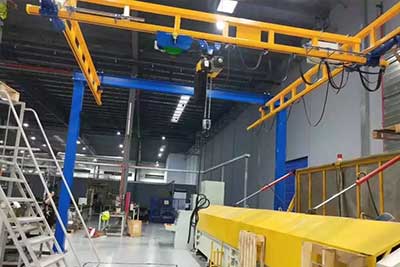
Floor Mounted Light Duty Overhead Cranes
Contrastingly, floor-mounted cranes are installed on the ground level, taking up a portion of the floor space. These cranes are advantageous in situations where the ceiling structure cannot accommodate the weight or where there are limitations in modifying the existing building structure.
Floor-mounted cranes offer ease of installation, requiring less structural reinforcement compared to ceiling-mounted counterparts. They are also relatively easier to relocate if the need arises. However, they might restrict floor space, which can affect other operations in the vicinity.
Deciding between a ceiling-mounted and a floor-mounted light duty overhead crane depends significantly on the specific needs of the operation. Factors such as available space, building structure, workflow, and the frequency of crane use play a pivotal role in this decision-making process.
Ceiling-mounted cranes provide a clutter-free floor space, optimizing the ground level for other activities. On the other hand, floor-mounted cranes offer a more straightforward installation process and can be a suitable choice when modifications to the building structure are limited.
Light Duty Overhead Crane Systems
Light duty overhead crane systems represent a vital aspect of material handling in various industries, offering efficient lifting solutions within the weight range of 250kg to 1000kg. Understanding the components, functions, and critical considerations associated with these systems is paramount for ensuring optimal performance and safety in industrial settings.
Components, Functions, and Key Considerations
Light duty overhead crane systems are composed of several integral components working together to facilitate lifting and movement tasks. Key components include the crane bridge, end trucks or trolleys, hoist mechanism, runway beams, and electrical systems. The crane bridge serves as the primary structure, supported by end trucks or trolleys for smooth movement along the runway beams. The hoist mechanism enables lifting, while the electrical systems ensure control and operation.
Each component within the system plays a vital role in ensuring the efficiency and safety of the lifting process. Regular maintenance and periodic inspections of these components are crucial to guarantee optimal functionality and to identify any potential issues that might compromise safety or efficiency.
Factors in Choosing the Right System
Selecting the appropriate light duty overhead crane system involves a thorough assessment of several critical factors. Load capacity stands as a fundamental consideration, determining the maximum weight the crane system can handle. It's imperative to align the system's capacity with the actual lifting requirements to ensure safe and efficient operations.
Moreover, considering the span and height of the crane system is pivotal. Span refers to the distance between the runways, indicating the coverage area of the crane, while height influences the lifting capabilities within the workspace. Properly assessing these factors ensures that the crane effectively covers the required operational area while meeting lifting needs.
Emphasis on Safety Compliance and Measures
Safety remains a top priority in the operation of light duty overhead crane systems. Industries must strictly adhere to safety protocols and regulations to mitigate potential risks and safeguard personnel and equipment. Safety measures encompass routine inspections, operator training programs, regular equipment maintenance, and strict compliance with industry safety standards and regulations.
Prioritizing safety ensures the prevention of accidents and injuries, prolongs the lifespan of the equipment, and maintains an efficient and secure working environment.
Light Gantry Cranes and Light Duty Gantry Crane Systems
Light gantry cranes present a versatile and efficient solution for material handling tasks within the weight capacities of 250kg to 1000kg. Understanding their defining characteristics, advantages, and diverse configurations is essential for industries seeking adaptable lifting solutions.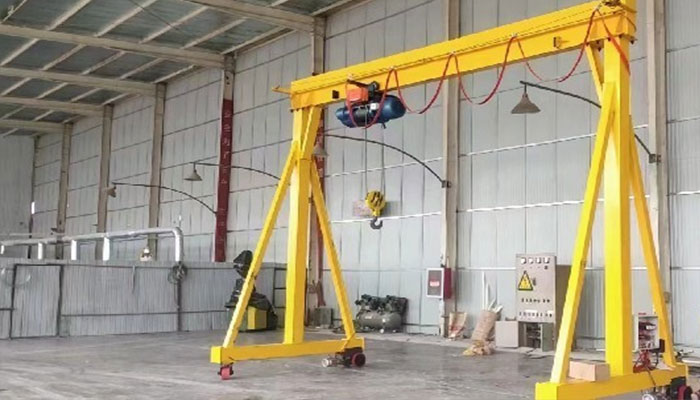
Light gantry crane for sale
Defining Characteristics, Advantages, and Application Scenarios
Light gantry cranes are characterized by their portability, enabling them to be moved easily within a workspace or between different areas. Their adaptability makes them suitable for diverse applications, including workshops, assembly lines, warehouses, and smaller manufacturing units. These cranes offer flexibility in load handling, allowing for the precise and controlled movement of goods in various environments.
One of the primary advantages of light gantry cranes is their ability to provide efficient lifting capabilities without the need for a fixed infrastructure or installation. This feature makes them a cost-effective option for businesses that require occasional or temporary lifting solutions. Additionally, their versatility and easy maneuverability enhance productivity in dynamic work environments.
Diverse Types and Configurations
Light gantry cranes come in various types and configurations to cater to different operational needs. Portable gantry cranes, for instance, offer mobility and ease of relocation, allowing for flexible usage across multiple workstations. Adjustable height gantry cranes provide the advantage of altering the lifting height, accommodating various load sizes and workspace requirements.
Other configurations may include semi-permanent gantry cranes designed for specific applications that require a more stable setup than portable variants. These diverse configurations enable industries to select the most suitable type of light gantry crane based on their specific lifting demands and operational settings.
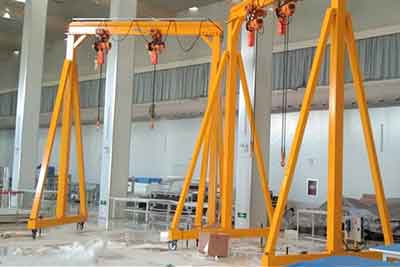
Steel Light Gantry Cranes are engineered with robust steel materials, offering durability and high load-bearing capacity. These cranes are designed to withstand heavy-duty operations while maintaining structural integrity. They find application in environments demanding reliable and sturdy lifting solutions.
The use of steel in their construction ensures resilience and longevity, making these cranes suitable for industries requiring consistent and substantial load handling. Their robustness allows for the efficient handling of heavier materials or equipment within the specified weight capacities, ensuring stability and reliability in demanding work environments.
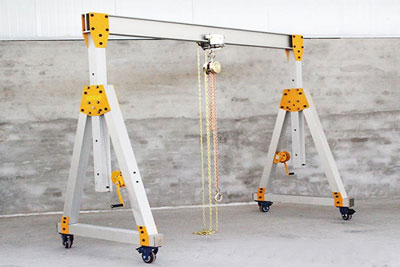
Aluminum Light Gantry Cranes, on the other hand, are built using lightweight yet durable aluminum materials. They prioritize mobility and ease of relocation, offering corrosion resistance and agility for versatile material handling tasks across various workstations or job sites.
The lightweight construction of aluminum gantry cranes allows for swift assembly, disassembly, and transportation, making them suitable for applications requiring frequent movement or usage in diverse locations. Their corrosion-resistant properties ensure durability even in challenging environmental conditions.

Fixed Height Light Gantry Cranes
Fixed Height Light Gantry Cranes feature a static height configuration, meaning the height of the crane remains constant and cannot be adjusted. These cranes are suitable for applications where consistent lifting heights are required, and there's no need for height adjustments based on load variations or workspace alterations.
Industries with steady lifting requirements or dedicated work areas benefit from the reliability and simplicity of fixed height gantry cranes, providing consistent lifting capabilities without the need for height adjustments.
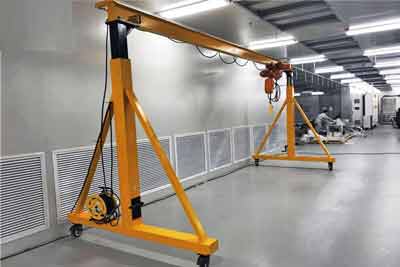
Adjustable Light Gantry Cranes
Adjustable Light Gantry Cranes offer the flexibility to modify the crane's height as needed. This adjustability enables operators to vary the lifting height based on load sizes, workspace requirements, or specific operational demands.
These cranes are ideal for applications where versatility in lifting heights is crucial. They allow for customization, accommodating various load sizes and adapting to changing operational needs within the workspace, providing adaptability and efficiency in material handling.
Each of these types of light gantry cranes offers distinct advantages and functionalities tailored to different operational requirements and industrial settings, allowing for diverse and efficient material handling solutions.
Light Duty Gantry Crane Systems
Light duty gantry crane systems represent a pivotal facet of material handling solutions, showcasing unique features, versatility, and applicability within the weight capacities of 250kg to 1000kg. Exploring their distinctive features, comparative analysis, and ideal industry applications provides valuable insights into their suitability for diverse operational settings.
Features and Functionality
Light duty gantry crane systems comprise several key features that contribute to their efficiency and effectiveness in material handling operations. These systems typically consist of a sturdy gantry frame structure supported by wheels or casters for mobility. The inclusion of a hoist mechanism facilitates lifting and movement of loads within the specified weight range.
One of the prominent advantages of light duty gantry crane systems is their mobility. The portability of these systems allows for flexible deployment across various workstations or locations within a facility. Additionally, their ease of assembly and disassembly makes them an ideal solution for applications requiring temporary lifting arrangements.
Comparative Analysis
Comparatively, light duty gantry crane systems offer a balance between functionality and mobility when compared to fixed overhead crane systems. While overhead cranes boast higher load capacities and fixed installation, light duty gantry crane systems excel in their maneuverability and adaptability. These systems can be quickly repositioned or relocated based on shifting operational needs without the requirement for complex structural modifications.
Functionality and Mobility:
- Light Duty Gantry Crane Systems: These systems strike a balance between functionality and mobility. They excel in maneuverability and adaptability due to their portable nature, allowing for swift repositioning or relocation as operational needs change. Their mobility facilitates easy movement across workstations or different areas without the need for extensive structural modifications.
- Fixed Overhead Crane Systems: On the other hand, fixed overhead crane systems are characterized by higher load capacities and a stationary installation. They offer robust lifting capabilities but lack the flexibility and mobility of gantry crane systems. Once installed, changes in their position or relocation require significant structural adjustments.
Installation and Flexibility:
- Light Duty Gantry Crane Systems: These systems are relatively simpler to install compared to fixed overhead cranes. Their setup typically involves minimal groundwork, as they do not require permanent fixtures or alterations to the building structure. The ease of installation enhances their adaptability to various work environments.
- Fixed Overhead Crane Systems: Fixed overhead cranes demand structural modifications and precise installation, which can be time-consuming and costly. Their stationary nature limits flexibility, making them less suitable for dynamic operational settings that require frequent repositioning.
Ideal Industry Applications
Light duty gantry crane systems find application in a spectrum of industries due to their versatility and ease of use. They are well-suited for smaller workshops, maintenance areas, construction sites, and environments where the lifting requirements are intermittent or dynamic. Their ability to handle moderate loads efficiently makes them an asset in assembly lines, warehouses, and manufacturing units dealing with smaller components or products.
Industries that value flexibility and adaptability in their material handling processes often find light duty gantry crane systems invaluable due to their ability to facilitate lifting tasks without the constraints of a fixed infrastructure.
The versatility and user-friendly design of light duty gantry crane systems make them well-suited for a wide array of industries and specific applications:
- Smaller Workshops and Maintenance Areas: - These systems are ideal for smaller workshops and maintenance areas due to their adaptability and space-saving features. Their maneuverability within confined spaces ensures efficient material handling without compromising on lifting capabilities.
- Construction Sites and Dynamic Environments: - Light duty gantry crane systems excel in construction sites and dynamic environments where lifting needs are intermittent or subject to frequent changes. Their portability and flexibility cater to shifting operational demands without hindering productivity.
- Assembly Lines and Warehouses: - In assembly lines and warehouses dealing with smaller components or products, these crane systems efficiently handle moderate loads. Their ability to navigate across different workstations offers a valuable advantage in streamlining operations.
In summary, the portability, adaptability, and moderate load-handling capabilities of light duty gantry crane systems make them invaluable assets across various industries, especially in settings requiring mobility, flexibility, and efficient material handling solutions.
Light Jib Cranes & Jib Crane Systems
Light jib cranes stand as versatile lifting solutions designed to handle specific weight capacities within the range of 250kg to 1000kg. Understanding their diverse features, benefits, and industry applications, along with an examination of different variants and configurations, sheds light on their adaptability and suitability across various operational scenarios.
Detailing Light Jib Crane Features, Benefits, and Industry Applications
Light jib cranes are characterized by their pivotal structure, comprising a horizontal boom or arm attached to a vertical support pillar or wall mount. These cranes provide a rotational movement around their axis, enabling precise and controlled lifting and positioning of loads within their specified weight range.
The benefits of light jib cranes are multifaceted. They offer increased maneuverability and accessibility in confined spaces, allowing for efficient material handling in areas with restricted overhead clearance or limited floor space. Industries such as workshops, small factories, maintenance areas, and assembly lines find these cranes particularly advantageous due to their ability to handle moderate loads with ease.
Examining Different Variants and Configurations
Light jib cranes come in various configurations tailored to suit specific operational requirements. Wall-mounted jib cranes, for instance, are affixed to walls or pillars, conserving floor space while providing optimal lifting capabilities. Floor-mounted jib cranes, on the other hand, stand freely on the ground, offering versatility in movement and placement within the workspace.
Furthermore, articulating jib cranes feature an additional articulating arm, providing extended reach and maneuverability for precise load positioning. Additionally, freestanding jib cranes offer mobility and ease of relocation, making them suitable for dynamic work environments that require flexible lifting solutions.
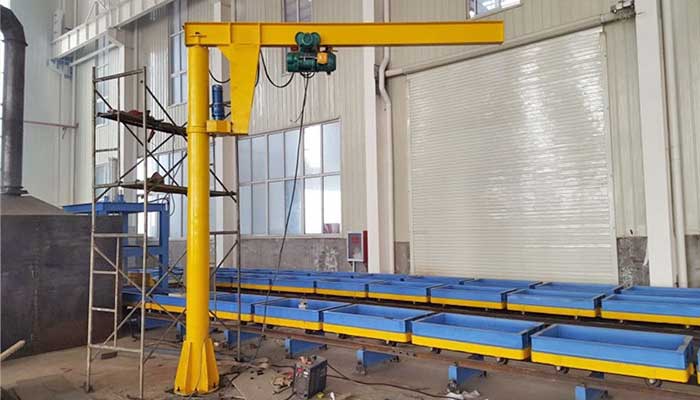
Light Duty Floor Mounted Jib Cranes
Light duty floor mounted jib cranes represent a versatile and space-saving solution for material handling tasks within weight capacities ranging from 250kg to 1000kg. Understanding their installation features, compact space benefits, and appropriate industry uses sheds light on their efficiency and suitability in various operational environments.
Installation Features
Floor-mounted jib cranes are designed to stand freely on the ground, making their installation relatively straightforward compared to other types of jib cranes. The installation typically involves securing the crane to a stable and load-bearing foundation using anchor bolts or concrete pads, ensuring stability during lifting operations.
These cranes are engineered to withstand vertical and horizontal loads while offering a 360-degree rotation, providing extensive coverage within the workspace. Their robust design and solid base ensure durability and reliability in demanding industrial environments.
Compact Space Benefits
One of the primary advantages of light duty floor mounted jib cranes is their ability to maximize space efficiency. These cranes occupy minimal floor space while offering substantial lifting capabilities. Their compact footprint makes them an excellent choice for environments with limited floor space, allowing for efficient material handling without obstructing other operational activities.
Floor-mounted jib cranes are particularly useful in areas where the utilization of overhead space is impractical or restricted. Their compact design enables them to navigate through aisles and workstations with ease, enhancing maneuverability and accessibility.
Appropriate Industry Uses
Light duty floor mounted jib cranes find extensive application across various industries due to their versatility and space-saving design. They are commonly employed in workshops, manufacturing units, maintenance areas, and assembly lines where maneuverability and precise load handling are essential.
These cranes excel in scenarios where lifting tasks need to be performed in confined spaces or where the installation of ceiling-mounted or wall-mounted cranes is not feasible. Their ability to handle moderate loads efficiently makes them an asset in industries requiring versatile and space-efficient lifting solutions.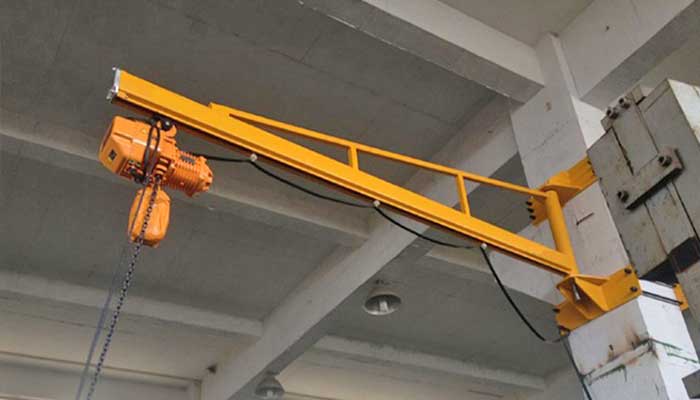
Light Duty Wall-Mounted Jib Crane
Light duty wall-mounted jib cranes offer a space-saving and efficient material handling solution within weight capacities ranging from 250kg to 1000kg. Understanding their installation highlights, compact space benefits, and industry suitability sheds light on their effectiveness and applicability in diverse operational environments.
Installation Highlights
Wall-mounted jib cranes are specifically designed to be affixed to walls or support pillars, utilizing vertical space and leaving the floor area unobstructed. The installation involves securing the crane to a sturdy and load-bearing wall structure using appropriate fixtures and brackets. Ensuring that the wall or support structure can withstand the imposed loads is essential for the safe operation of these cranes.
The installation process typically involves careful planning and consideration of the load-bearing capacity of the wall or pillar to ensure the crane's stability during lifting operations. This installation method optimizes space utilization by freeing up valuable floor space for other operational activities.
Compact Space Benefits
One of the primary advantages of light duty wall-mounted jib cranes is their ability to conserve floor space while providing effective lifting capabilities. These cranes pivot around their mounting point, offering a 180-degree or full 360-degree rotation, depending on the configuration. This rotational capability allows for flexible load positioning within the designated workspace.
Wall-mounted jib cranes excel in environments where floor space is limited or where unobstructed movement across the ground is crucial for other operational tasks. Their compact design enables efficient material handling without impeding workflow or obstructing the movement of equipment and personnel.
Industry Suitability
Light duty wall-mounted jib cranes find extensive application across various industries due to their space-saving design and versatility. They are well-suited for use in workshops, manufacturing units, maintenance areas, and assembly lines where space optimization and precise load handling are essential.
These cranes are particularly beneficial in environments where the utilization of overhead space is limited or where floor-mounted cranes would impede operations. Their ability to efficiently handle moderate loads while occupying minimal floor space makes them an ideal choice for industries requiring efficient and compact material handling solutions.
Essential Considerations for Buyers and Users
Making informed decisions regarding the acquisition and utilization of light crane systems involves careful consideration of various factors. These essential considerations encompass budgetary aspects, maintenance requirements, infrastructure integration, as well as the prioritization of operator training and safety protocols.
Budgetary Aspects
Understanding the financial implications associated with acquiring a light crane system is crucial. Buyers need to evaluate not only the initial purchase cost but also ongoing expenses, including installation, maintenance, repairs, and potential upgrades. Assessing the return on investment (ROI) concerning increased productivity, efficiency gains, and reduced operational downtime is essential in determining the cost-effectiveness of the chosen system.
Maintenance Requirements
Regular maintenance is pivotal for ensuring the longevity and optimal performance of light crane systems. Buyers and users should familiarize themselves with the manufacturer's recommended maintenance schedules and procedures. Scheduled inspections, lubrication, part replacements, and adherence to maintenance protocols are essential to prevent breakdowns, enhance safety, and extend the system's lifespan.
Infrastructure Integration
The seamless integration of a light crane system into existing infrastructure requires thorough planning and assessment. Buyers need to evaluate the structural compatibility of the installation area, ensuring that the building or site can support the crane's weight and operational requirements. Additionally, factors such as power supply, access to control panels, and any required modifications to the workspace need to be considered for effective integration.
Prioritizing Operator Training and Safety Protocols
Operator training and adherence to safety protocols are paramount for the safe and efficient use of light crane systems. Providing comprehensive training programs for operators ensures they understand the system's functionality, safety features, and operational procedures. Emphasizing safety protocols, including load capacity limits, proper lifting techniques, and the use of personal protective equipment (PPE), mitigates the risk of accidents and injuries in the workplace.
These essential considerations for buyers and users of light crane systems aim to guide informed decision-making processes. By evaluating budgetary aspects, understanding maintenance requirements, ensuring infrastructure compatibility, and prioritizing operator training and safety protocols, industries can maximize the efficiency, safety, and longevity of their light crane system investments.
The exploration of light crane types and systems within weight capacities ranging from 250kg to 1000kg underscores the versatility, efficiency, and adaptability of these lifting solutions across diverse industries. As we conclude this comprehensive guide, let's recap the covered light crane types and systems, highlight their benefits and real-world applications, and encourage informed decision-making for both buyers and users.
Conclusion: Get Custom Light Crane & Light Crane System
Throughout this guide, we delved into various light crane types and systems, offering insights into their unique features, functionalities, and suitability for specific operational needs. From light duty overhead cranes and gantry cranes to jib cranes in floor-mounted and wall-mounted configurations, each type showcases distinctive characteristics tailored to address diverse material handling requirements within their respective weight capacities.
Highlighting Benefits
The benefits of these light crane types and systems are multifaceted. They offer efficient lifting solutions while optimizing space, enhancing maneuverability, and ensuring precise load handling. Real-world applications span across workshops, manufacturing units, maintenance areas, assembly lines, and various industries seeking flexible, cost-effective, and space-saving material handling solutions.
These cranes have proven instrumental in streamlining operations, boosting productivity, and mitigating workplace hazards, thereby contributing to smoother and more efficient industrial workflows.
Encouraging Informed Decision-Making for Buyers and Users
To buyers and users considering the adoption or upgrade of light crane systems, it's imperative to prioritize informed decision-making. Understanding the specific operational requirements, conducting thorough assessments of budgetary aspects, maintenance needs, and infrastructure compatibility, and emphasizing operator training and safety protocols are key elements in maximizing the value and efficiency of these systems.
By making well-informed decisions aligned with the operational demands and safety standards of their respective industries, buyers and users can harness the full potential of light crane types and systems, ensuring safer, more efficient, and productive material handling operations.
As technology continues to evolve, these light crane systems are poised to adapt and integrate advancements, catering to the ever-changing needs of modern industries.




